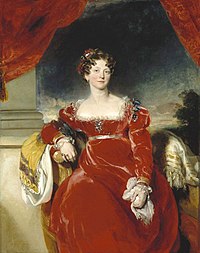Princess Sophia of the United Kingdom
| Princess Sophia | |||||
|---|---|---|---|---|---|

Princess Sophia, c. 1825, painting by Sir Thomas Lawrence
|
|||||
| Born |
3 November 1777 Buckingham House, London |
||||
| Died | 27 May 1848 (aged 70) Kensington Palace, London |
||||
| Burial | Kensal Green Cemetery, London | ||||
|
|||||
| House | Hanover | ||||
| Father | George III | ||||
| Mother | Charlotte of Mecklenburg-Strelitz | ||||
| Full name | |
|---|---|
| Sophia Matilda |
The Princess Sophia (Sophia Matilda; 3 November 1777 – 27 May 1848) was the 12th child and 5th daughter of King George III and Charlotte of Mecklenburg-Strelitz. Sophia is perhaps best known for the rumours surrounding a supposed illegitimate child to which she gave birth as a young woman.
In her youth, Sophia was closest to her father, who preferred his daughters over his sons; however, she and her sisters lived in fear of their mother. The princesses were well-educated but raised in a rigidly strict household. Though he disliked the idea of matrimony for his daughters, King George had intended to find them suitable husbands when they came of age. However, the King's recurring bouts of madness, as well as the Queen's desire to have her daughters live their lives as her companions, stopped would-be suitors from offering for the most of the princesses. As a result, Sophia and all but one of her sisters grew up in their mother's cloistered household, which they frequently referred to as a "Nunnery".
Though she never wed, rumours spread that Sophia became pregnant by Thomas Garth, an equerry of her father's, and gave birth to an illegitimate son in the summer of 1800. Other gossip declared the child was the product of rape by her elder brother the Duke of Cumberland, who was deeply unpopular. Historians are divided on the validity of these stories, as some believe she gave birth to Garth's child while others call them tales spread by the Royal Family's political enemies.
The efforts of the Prince Regent to gain his sisters increased independence were further hastened along with Queen Charlotte's death in 1818. In her last years, Sophia resided in the household of her niece Princess Victoria of Kent (the future Queen Victoria), at Kensington Palace. There, she fell under the sway of Victoria's comptroller, Sir John Conroy, who took advantage of her senility and blindness; rumours also circulated that Sophia was in awe of Conroy because of his ability to deal effectively with the "bullying importunities" of Sophia's supposed illegitimate son. Sophia frequently served as his spy on the Kensington household as well as on her two elder brothers, while Conroy squandered most of her money. The princess died on 27 May 1848 at her residence in Vicarage Place, Kensington Palace.
...
Wikipedia
